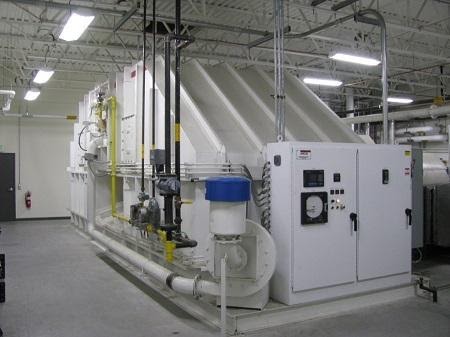 The Challenge
The Challenge
A specialty ceramic material manufacturer in the United States operates several custom-built furnaces in their manufacturing process. Sometimes referred to as kilns, these high-temperature process devices are generally a major source of air pollutants and require an abatement technology to meet environmental regulations with the state or federal agencies. As is the case with many industrial manufacturing operations, emissions are best destroyed through the use of oxidation technologies. Thermal and catalytic oxidizers utilize temperature, time and turbulence to destroy emissions. This particular manufacturer was operating direct-fired thermal oxidizers, as well as Regenerative Thermal Oxidizers (RTOs) for abatement of the various emission streams at this one facility.
The Solution
For one of these processes, this manufacturer needed an RTO to be installed onto a mezzanine inside the building. A special design was required to fit within the height restrictions, yet tall enough for the RTO to operate. Anguil Environmental designed and built the RTO with high-cell density ceramic media to still get 95% thermal energy recovery, but with a much shorter bed elevation. This, along with other design changes, allowed the equipment to be installed inside the building on the mezzanine with a very short vertical dimension.
Having successfully worked with the company before, they again turned to Anguil for a destruction device for another process within their facility. The preferred location for the installation was equally challenging as the last, also on a mezzanine. In this application, the process exhaust was already quite warm, within the temperature range normally associated with catalytic oxidation temperatures (600°F or higher). Rather than design a heavy RTO to fit into this area, Anguil designed and built a catalytic oxidizer to remove the Volatile Organic Compounds (VOCs) and Hazardous Air Pollutants (HAPs) from their exhaust. Since the process exhaust temperature was already hot enough to sustain high levels of oxidation with the catalyst, the oxidizer was supplied without a heater or a heat exchanger. This allowed for a very simple method of controlling the emissions from the process with reduced capital and installation costs.
On the discharge of a third process line, they were operating an older (non-Anguil) RTO to treat the VOCs and HAPs. This specific process required the use of nitrogen to keep the internal kiln chamber starved of oxygen. The inert gas stream allows their end products to cure properly.
Nearing the end of its life cycle, the aging RTO utilized poppet valves to direct airflow within the destruction device and maximize energy recovery within the oxidizer. This process continues to alternate and repeat during normal operation of the RTO, approximately every three to five minutes. The RTO diverter valves were designed without a pressure relief system, meaning that pulses of pressure were traveling back up the ductwork into the process equipment each time the RTO poppets switched. Internal pressure within the kilns affected the control and usage of nitrogen and negatively impacted the process operation and operating costs.
The RTO technology is generally considered to be the most efficient oxidation device and is therefore the most commonly used. However, this manufacturer was successfully utilizing catalytic oxidizers for emission control on another process and felt one should be applied here as well. They wanted a technology that would not only keep them in compliance, but do it without the pressure pulses that had been negatively impacting the process equipment.
Having supplied both thermal and catalytic oxidizers to this facility before, Anguil was called in once again to evaluate the situation and make equipment recommendations. Anguil, along with engineers at this customer, selected a catalytic oxidizer for this unique process. The Products of Combustion (POC) from any oxidizer are Carbon Dioxide (CO2), water vapor and heat. Anguil designed and manufactured this catalytic system with multiple heat exchangers to utilize the heat generated during combustion. The added benefit of this third Anguil control system is that it re-circulates inert oxidizer POC back into their process.
A secondary heat exchanger downstream of the oxidizer cools the treated air so that it can supply the process with tempered supply gas. To enable reentry into the kiln, oxygen concentrations leaving the catalytic oxidizer are maintained at very low levels with custom designed electronic control systems, supply fans and ductwork. Maintaining low oxygen levels and recirculating this offgas reduces the amount of nitrogen required by the process and therefore lowers operating costs for this production line. In addition, a primary heat exchanger within the oxidizer was designed to minimize fuel consumption of the abatement device itself, using heat from the exothermic reaction to preheat incoming pollutants.
The Result
The 20,000 SCFM (32,100 Nm3/hr), Anguil thermal oxidizer was installed indoors, near the process equipment. To keep it under negative pressure at all times, Anguil manufactured the oxidizer in an induced draft fan configuration. Pulling gases through the system with the main fan ensures that no oxygen depleted gases are emitted into the building where personnel were present.
Anguil differentiates itself from the competition by offering all of the different oxidizer technologies used for the destruction of pollutants. This ensures an unbiased equipment selection for each application based on the destruction requirements, efficiency needs and process parameters. They not only design, manufacture, service and install Regenerative Thermal Oxidizers (RTOs), but also direct-fired, catalytic and thermal recuperative systems. Each one of these oxidizer types uses high temperature combustion in a unique manner to best suit each application.

